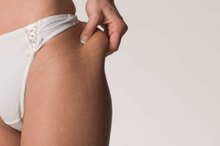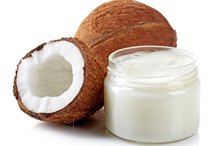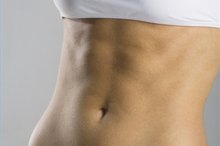What does fact checked mean?
At Healthfully, we strive to deliver objective content that is accurate and up-to-date. Our team periodically reviews articles in order to ensure content quality. The sources cited below consist of evidence from peer-reviewed journals, prominent medical organizations, academic associations, and government data.
- Harvard Health Publications: Abdominal Fat and What to Do About It
- PubMed: A Prospective Study of Waist Circumference and Body Mass Index in Relation to Colorectal Cancer Incidence
- PubMed: A Prospective Study of Waist Circumference and Body Mass Index in Relation to Colorectal Cancer Incidence
The information contained on this site is for informational purposes only, and should not be used as a substitute for the advice of a professional health care provider. Please check with the appropriate physician regarding health questions and concerns. Although we strive to deliver accurate and up-to-date information, no guarantee to that effect is made.
What Are the Causes of Women's Middle Age Belly Fat?
While both men and women may accumulate belly fat, menopausal women are often the hardest hit, as the ratio of fat to muscle changes and fat starts to be deposited higher on the body. During the childbearing years, fat is more likely to accumulate in the hips and thighs. At menopause, as estrogen declines, cortisol, the hormone your body produces when you are under stress, increases; and due to the hormonal changes that occur during menopause, the midsection often expands after middle age.
Visceral Fat
Abdominal, or visceral, fat is different than the subcutaneous fat on the surface near the skin 2. Visceral fat is deeper in your abdominal cavity, padding the spaces between the organs in your midsection. This type of fat is associated with heart disease, diabetes and some forms of cancer. As you age, your metabolism rate declines and you begin to have a more difficult time burning off excess fat, especially if you are a woman. Some people are also genetically predisposed to fat deposition in the tummy and midsection.
- Abdominal, or visceral, fat is different than the subcutaneous fat on the surface near the skin 2.
- Visceral fat is deeper in your abdominal cavity, padding the spaces between the organs in your midsection.
Function
Why Are Love Handles the Last Place to Lose Weight?
Learn More
Visceral fat cells are not just energy storehouses, but instead play a role in churning out a variety of hormones that have effects on bodily processes such as insulin resistance and breast cancer. Your body has a good reason for depositing fat in your midsection, because unlike body parts such as arms and legs that you must swing and move frequently, the torso is an ideal location because it takes the least amount of energy to store it there. Your body will also preferentially store fat wherever you already have existing fat cells formed earlier in your life.
- Visceral fat cells are not just energy storehouses, but instead play a role in churning out a variety of hormones that have effects on bodily processes such as insulin resistance and breast cancer.
- Your body has a good reason for depositing fat in your midsection, because unlike body parts such as arms and legs that you must swing and move frequently, the torso is an ideal location because it takes the least amount of energy to store it there.
Body Shape and Hormonal Factors
According to Harvard Medical School, if you are pear-shaped, with much of your fat in your thighs and bottom, the fat you are dealing with is probably more subcutaneous fat. However, if your body is more apple-shaped, with your fat stores concentrated right around your middle, you are much more likely to also have visceral fat underneath. At menopause, as estrogen declines, cortisol, the hormone your body produces when you are under stress, increases. High cortisol levels are associated with visceral fat accumulation, but other hormonal changes after menopause may also contribute to accumulation of this dangerous fat. Even if you are of a normal weight and are not experiencing weight gain, you need to be aware that the fat you already had on your body may be shifting locations due to the hormonal changes your body is experiencing.
- According to Harvard Medical School, if you are pear-shaped, with much of your fat in your thighs and bottom, the fat you are dealing with is probably more subcutaneous fat.
- However, if your body is more apple-shaped, with your fat stores concentrated right around your middle, you are much more likely to also have visceral fat underneath.
Exercise Helps
What Are the Causes of Severe Cellulite in Thin People?
Learn More
Regular exercise is one effective method for staving off the accumulation of fat around your midsection, according to Harvard Medical School. Duke University Medical Center researchers showed that sedentary participants in a study gained almost 9 percent in visceral fat in only six months. Those who exercised a moderate amount did not add visceral fat, and those who exercised at an even higher level actually lost some of their subcutaneous fat. Using weights when you exercise can help you reduce belly fat. Your dietary choices are also important. You should eat a diet rich in fresh fruits and vegetables, low-fat dairy products, lean meats and whole-grain breads, cereals and pasta.
- Regular exercise is one effective method for staving off the accumulation of fat around your midsection, according to Harvard Medical School.
- Duke University Medical Center researchers showed that sedentary participants in a study gained almost 9 percent in visceral fat in only six months.
Related Articles
References
- Harvard Health Publications: Abdominal Fat and What to Do About It
- Natural News: The Truth on Losing Abdominal Body Fat - Forget the Diet Hype, Here's How It Really Works
- PubMed: A Prospective Study of Waist Circumference and Body Mass Index in Relation to Colorectal Cancer Incidence
- Assessing Your Weight. Centers for Disease Control and Prevention.
- American Council on Exercise. ACE Health Coach Manual. 2013.
- American Council on Exercise. ACE Personal Trainer Manual. 2012.
Writer Bio
Paul Elsass started writing in 1986. He has written articles for the Clinical Exercise Physiology Association and multiple medical-fitness centers. Elsass has certifications through the American College of Sports Medicine and the American Council on Exercise. He holds a Bachelor of Science in Kinesiology from the University of Texas and a Master of Science in Management from Northern Arizona University.









